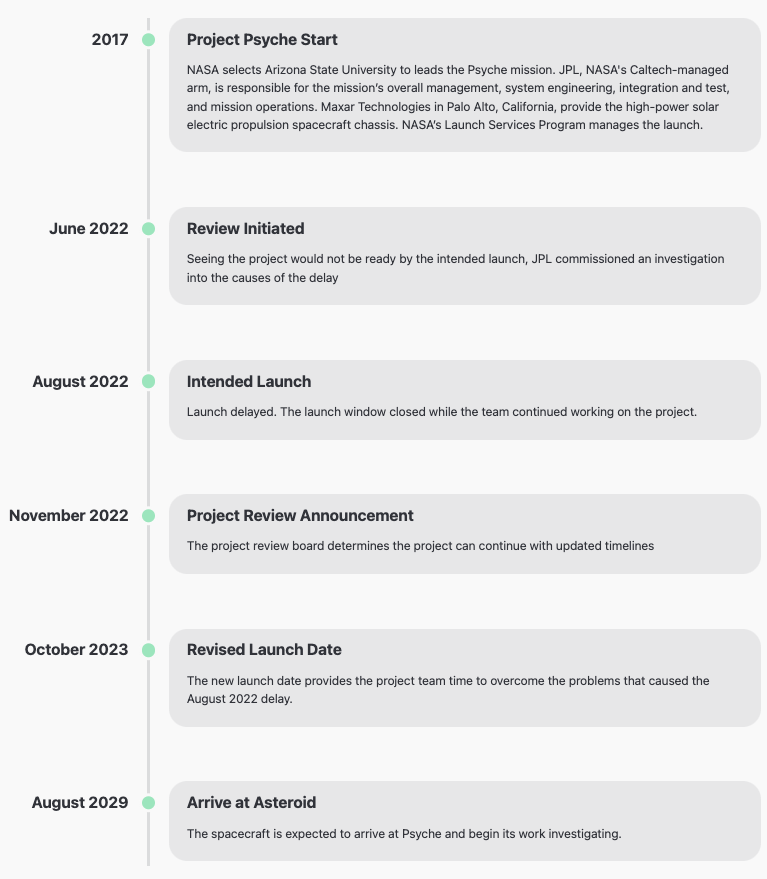Mission to Psyche
🚀 LAUNCH UPDATE: NASA will move forward with the #MissiontoPsyche!
— NASA's Launch Services Program (@NASA_LSP) November 2, 2022
A planetary window is set to open October 10, 2023 for the Psyche spacecraft to head to a metal-rich asteroid of the same name.
Psyche will arrive at the asteroid in August 2029. 🛰https://t.co/E1MBrsyLDH
Things that happen in space often feel remote and disconnected from the lives most of us live. The excitement of the Twitter announcement above is no exception; August 2029 is far away, Psyche is a name virtually nobody connects with asteroids and planetary windows a year from now don't help pay for gas or put food on the table. So, let's dig below the surface to see why this is important.
Asteroids aren't Just Dirty Snowballs
In the early 2010s, astronomers released information about the composition of some asteroids orbiting the sun between Mars and Jupiter. An M-type asteroid (1 km diameter) could contain 2B tonnes of iron-nickel ore. A metallic asteroid with a 1.6 km diameter could carry \\(20 trillion of useful metals. A 30 m asteroid *may* contain as much as \\)50B in platinum. 16 Psyche (Psyche, for short) is 220 km in diameter and is estimated to contain \(1.7\times10^{19}\) kg of iron ore.1
Such impressive wealth (from a resource perspective) is part of the reason in 2017 NASA approved a science mission to explore the almost-planet thoroughly. But there was more to it than just greed.
From Greed to Knowledge
The other day, the wife and I visited the natural history wing of our local museum, an impressive exercise in trying to convey how much we know and paper over how little we actually know.
Looking at the image of the molten core of our planet, she asked the obvious question: how do scientists know?
The truth is, they don't can't.
There is no way we can directly look sense the core — it's too hot and pressurized — so we use complex mathematical modelling to make extremely educated guesses.
16 Psyche appears to have an exposed nickel-iron core, the type usually found in early planets or at the core of Earth. Excuse the pun, but this is earth shattering! Unable to observe Earth's core directly, Psyche provides an opportunity to study this unique material and gain insight into our own planet's makeup. Like all paradigm-shifting discoveries, what we learn at 16 Psyche might fundamentally change our relationship with our planet.
The Mission
So, NASA put together a 3.5 year mission to reach this asteroid and study it with an imager, magnetometer, and gamma-ray spectrometer. The plan included spending 21 months in orbit around the body to examine its nature (core or unmelted material), its topography characteristics, and the relative ages of its regions.
And then in June, with the August launch quickly approaching, the project missed its deadline. The delay meant missing the launch window, and JPL spun up a full review of the project. In the meantime, the project team kept working. 2
At the end of October, NASA completed the review and will publish its findings shortly. The team is already announcing the results with excitement, though. The new launch date is sect for October 10, 2023. 3
Here's the updated timeline…

Asteroid Mining
In 2014, estimates for asteroid mining were very lucrative. The estimates depend on extraction and selling the material on earth in such large quantities they would change the active price of the metal, making such estimates more fanciful than realistic. Basic supply and demand calculations apply. Such an influx of wealth could crash earthly markets.
So, here is where things come back down to Earth. Were you thinking to short the platinum market based on the information above, wait until after 2029 when information from the Psych spacecraft beams information back with its new laser communications technology.
In the interim, you might consider investing in space mining companies hoping to extract asteroid riches. Alternatively, explore some on-orbit manufacturers preparing to take resources mined in space and turn them into products for earthlings.
-
Genta, G. (2014). Private space exploration: A new way for starting a spacefaring society?. Acta Astronautica, 104(2), 480-486. ↩
-
Greicius, T. (2017, May 11). Psyche Overview [Text]. NASA. http://www.nasa.gov/mission_pages/psyche/overview/index.html ↩
-
Talbert, T. (2022, October 28). NASA Continues Psyche Asteroid Mission [Text]. NASA. http://www.nasa.gov/feature/nasa-continues-psyche-asteroid-mission ↩
